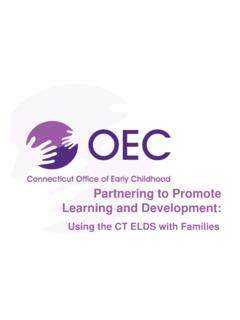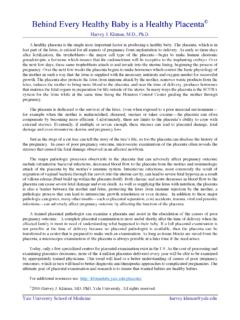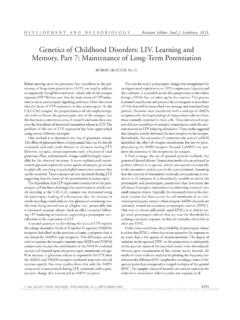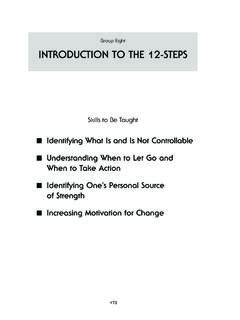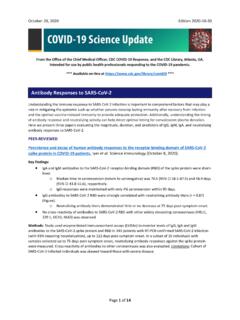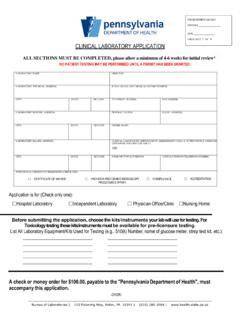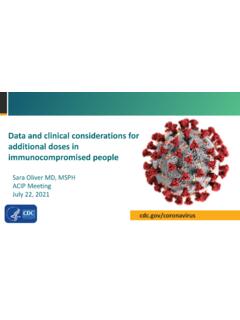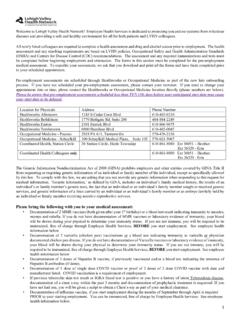Transcription of Syphilis Testing Reverse Algorithm Update
1 Vol 26 (2) Nov. 2017 Syphilis Testing Using the Reverse Algorithm : An Update Traditional Algorithm : The Venereal Disease Research Laboratory (VDRL) test for Syphilis was invented in its first iteration before WWI. The VDRL is a nontreponemal test used both as a screening test for Syphilis and as a measure of disease activity 1, 2. The basis of the test is that a patient with Syphilis produces an antibody that reacts with ox heart extract ( anti-cardiolipin antibodies). The rapid plasma reagin (RPR) test uses the same antigen as VDRL, but the antigen is bound to a carbon particle to allow visualization of the reaction without a microscope. VDRL or RPR titers are monitored to document response to therapy.
2 RPR titers are frequently higher than VDRL titers. Despite effective treatment some patients remain serofast with persistent low VDRL or RPR titers. Of note, many other medical conditions besides Syphilis can produce false positive VDRL or RPR results, including some virus infections, pregnancy, medications, and autoimmune diseases. Therefore, VDRL or RPR results are confirmed by a Treponema pallidum-specific antibody test, such as Treponema pallidum particle agglutination assay (TP-PA). Syphilis Reverse Algorithm : Since July 29, 2016, YNHH has employed a Reverse Syphilis test Algorithm which starts with an assay to measure specific IgM and IgG antibodies to Treponema pallidum. The advantages are that T.
3 Pallidum antibodies (TPA) are 1) specific to Syphilis , 2) are more sensitive than VDRL or RPR for detecting both primary and late Syphilis , 3) can be tested using automated instruments, and 4) can provide a more rapid time to result2. At YNHH, a chemiluminescence immunoassay is employed (Liaison Treponema Assay)3. Samples reactive by the TPA screen are reflexively tested by RPR within 24 hours to assess disease activity. If RPR is negative, the sample is reflexively tested by a second T. pallidum specific test, TP-PA, to confirm the initial TPA screen. If not previously treated for Syphilis , TPA+/RPR-/TP-PA+ results together suggest a late latent infection and therapy should be offered. If the validity of this result is questioned, Testing should be repeated in a month.
4 A negative TP-PA suggests a false positive TPA screen. If the patient is at risk for recent acquisition of Syphilis , retesting in a month is recommended. RPR Monitor: Once a patient has been found to be RPR positive, the patient should be monitored by RPR titers only to assess response to therapy. For previously RPR-positive patients only, order RPR Monitor [LAB3829]. Recognition of late latent Syphilis : The biggest clinical impact of the Reverse Algorithm is the recognition of untreated late latent Syphilis . Clinicians are referred to CDC STD Guidelines for treatment [ ]. If needed, clinicians can contact the CT DPH STD Control Department (860-509-7920) to inquire whether the patient has been previously reported or treated.
5 Neurosyphilis: The recommended CSF test for neurosyphilis remains VDRL1,2. Note: A positive serum Syphilis test is a prerequisite for CSF Testing . If serum Syphilis Testing is negative or has not been done, the CSF test will be cancelled. Test availability: The TPA screening test [LAB1197] is performed in the Clinical Virology Laboratory 6 days a week, Sun-Fri, as samples arrive ( not batch tested). RPR, either as a reflex test or if ordered to monitor known RPR positives, is performed once a day, Mon-Fri. TP-PA is performed once a week, either Thurs or Fri. Submit one gold top tube. The complete Interpretive Comments reported with the Syphilis Reverse Algorithm test results are shown in Table 1 below.
6 For questions, call the Virology Laboratory at 688-3524, or email the Virology or Microbiology Laboratory Directors below. Table 1. Reverse Algorithm : Interpretation provided with test results Test Result Interpretation Initial screen for T. pallidum antibodies (TPA) T. pallidum Ab screen Non-Reactive Non-Reactive for antibodies to Treponema pallidum, the causative agent of Syphilis . Equivocal Initial T. pallidum screening test equivocal. This could represent a true reactive or this could be a false reactive screening test. RPR Testing is being reflexively performed on this sample. Reactive Initial T. pallidum screening test reactive. This could represent a true reactive or a falsely reactive screening test.
7 RPR Testing is being reflexively performed on this sample. If TPA positive, reflex to RPR to assess disease activity RPR Non-Reactive Initial T. pallidum screening test reactive or equivocal but RPR test non-reactive. This may represent a true reactive screening test but could represent a false reactive*. TPPA Testing is being reflexively performed on this sample. Reactive Consistent with Syphilis (past or current infection). If RPR negative, reflex to TPPA to assess specificity of initial antibody screen T. pallidum Ab by TPPA Non-Reactive Unconfirmed T. pallidum screening test. Unlikely to be Syphilis . If patient is at-risk for Syphilis , retest in one month. Inconclusive Unconfirmed T. pallidum screening test.
8 If patient is at-risk for Syphilis , retest in one month. Reactive A reactive T. pallidum antibody initial screen (TPA), with a non-reactive RPR and a reactive second T. pallidum antibody test (TPPA), suggests exposure to Syphilis . Persons with a history of previous treatment will require no further treatment unless re-exposure is likely. In this instance, a repeat RPR in 2-4 weeks is recommended to evaluate for early infection. Those without a history of treatment for Syphilis should be offered treatment. Unless sexual history or physical examination suggest a recent infection, previously untreated persons should be treated for late latent Syphilis . Ref: CDC Syphilis 2015 Treatment Guidelines. If the accuracy of these results is questioned, repeat Testing in 2-4 weeks is recommended.
9 * Previously stated RPR-non-reactive likely represents a false reactive screening test result . Comment revised since our data show that >86% of TPA+/RPR nonreactive samples confirm as true reactive by TP-PA. References: 1. Treponema and Brachyspira, Human Host-associated Spirochetes, Manual of Clinical Microbiology, 11th Edition 2015, 2. CDC Syphilis 2015 Guidelines [ ] 3. Park IU, et al, Screening for Syphilis with the treponemal immunoassay: analysis of discordant serology results and implications for clinical management. J Infect Dis 2011; 204:1297-1304. Marie L. Landry, David Peaper, , Director, Clinical Virology Laboratory Director, Clinical Microbiology Laboratory

